Mátala, Crete, Greece, Sunday morning, 3 June 2001
Larissa is eleven today, and we are on Crete for the occasion as requested, but she is not yet up and about.
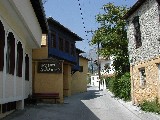

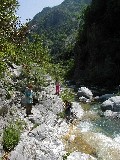 In our last month at Litóhoro, we had a lot of work and things to wrap up but still took a couple more hikes in the Enipea gorge. On the fifth of May, with Stas in England, I took the kids up. We took a novel route upward through town and happened across the gaily painted old house that is the "Pansion" Kallistô (left). Then we took the aqueduct trail to the dam, and found a way for the first time to go dry-shod (well, almost) up well past the next bend upstream, discovering new and lovely scenes.
In our last month at Litóhoro, we had a lot of work and things to wrap up but still took a couple more hikes in the Enipea gorge. On the fifth of May, with Stas in England, I took the kids up. We took a novel route upward through town and happened across the gaily painted old house that is the "Pansion" Kallistô (left). Then we took the aqueduct trail to the dam, and found a way for the first time to go dry-shod (well, almost) up well past the next bend upstream, discovering new and lovely scenes.
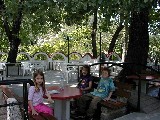 By this time the trail-head taverna called I Míli had its patio open, and we lunched there at a table with water running under it. The concrete table is rooted in the middle of a little spillway, which is spanned by the facing benches and by the steel footrests beneath them.
By this time the trail-head taverna called I Míli had its patio open, and we lunched there at a table with water running under it. The concrete table is rooted in the middle of a little spillway, which is spanned by the facing benches and by the steel footrests beneath them.
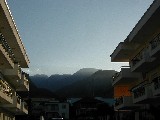 As our time drew shorter, we exhorted one another to imprint the image of the mountain forever in our brains and hearts. Here is a view from just outside our apartment building in the evening.
As our time drew shorter, we exhorted one another to imprint the image of the mountain forever in our brains and hearts. Here is a view from just outside our apartment building in the evening.

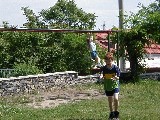 We all five took a farewell hike in the gorge just two days before our departure. As we made our way through town, we saw that people's balconies and gardens were reaching their peak of floral exuberance. The weather was getting uncomfortably warm for uphill walking, at least in town, so we took a break at the playground.
We all five took a farewell hike in the gorge just two days before our departure. As we made our way through town, we saw that people's balconies and gardens were reaching their peak of floral exuberance. The weather was getting uncomfortably warm for uphill walking, at least in town, so we took a break at the playground.
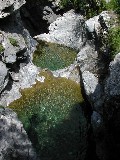
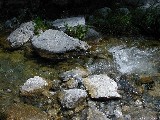
 We took the same route as before, past the clear and shady pools just below the dam, then across at the stepping stones, and on up.
We took the same route as before, past the clear and shady pools just below the dam, then across at the stepping stones, and on up.
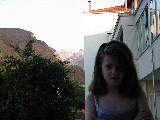
 The morning of our departure, Larissa was very sad to look her last, at least for a long while, on the mountain. Cousin Chrysóstomos and Déspina very kindly came from Kateríni in his 1975 Fiat to ferry us and our luggage down to the highway and to see us off on the bus for Athens. While they were at it they picked up our bookshelves, boom-box, and other leavings (even down to the coat hangers) for the hotel they run at Paralía Katerínis, which just lately is running them ragged. (They have added a new floor, and are racing to get it ready for guests already booked.) He had also paid us a visit the night before, with Chrysoúla, and we had visited them at Paralía for a swim at the beach and a large lunch on the hotel's patio the previous Saturday.
The morning of our departure, Larissa was very sad to look her last, at least for a long while, on the mountain. Cousin Chrysóstomos and Déspina very kindly came from Kateríni in his 1975 Fiat to ferry us and our luggage down to the highway and to see us off on the bus for Athens. While they were at it they picked up our bookshelves, boom-box, and other leavings (even down to the coat hangers) for the hotel they run at Paralía Katerínis, which just lately is running them ragged. (They have added a new floor, and are racing to get it ready for guests already booked.) He had also paid us a visit the night before, with Chrysoúla, and we had visited them at Paralía for a swim at the beach and a large lunch on the hotel's patio the previous Saturday.
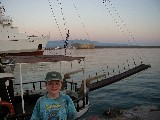 Sad as it was to say farewell to Mount Olympus, the next morning we were happy to say hello to Crete. Our sea passage had been easy and extremely punctual, leaving on the stroke of eight in the evening and arriving at six in the morning. We slept through most of it in a clean and tidy four-bunk cabin with bath, aboard a very large and new and lavishly appointed ferry, though our fare was marvelously cheap. Here you see Trevor, the stern of a classic wooden ketch named Kalypso, and the Venetian fort called Rocca del Mare guarding the old harbor of Iráklio (or Herakleion, formerly Candia). Here we waited in relative comfort at a waterside cafeteria for the Hertz rental office to open. At about seven Ariadne and I set off on foot for it. We were disappointed to get a Ford Focus instead of a Seat Cordoba; it meant that the children would have to sit three across in just two-thirds of the rear seat, the remainder being folded down to accommodate luggage. This has not been pleasant for them, and Trevor has had more than his usual carsickness in the mountains, but all things considered they have been pretty cheerful about it; fortunately, we have not had any really long drives.
Sad as it was to say farewell to Mount Olympus, the next morning we were happy to say hello to Crete. Our sea passage had been easy and extremely punctual, leaving on the stroke of eight in the evening and arriving at six in the morning. We slept through most of it in a clean and tidy four-bunk cabin with bath, aboard a very large and new and lavishly appointed ferry, though our fare was marvelously cheap. Here you see Trevor, the stern of a classic wooden ketch named Kalypso, and the Venetian fort called Rocca del Mare guarding the old harbor of Iráklio (or Herakleion, formerly Candia). Here we waited in relative comfort at a waterside cafeteria for the Hertz rental office to open. At about seven Ariadne and I set off on foot for it. We were disappointed to get a Ford Focus instead of a Seat Cordoba; it meant that the children would have to sit three across in just two-thirds of the rear seat, the remainder being folded down to accommodate luggage. This has not been pleasant for them, and Trevor has had more than his usual carsickness in the mountains, but all things considered they have been pretty cheerful about it; fortunately, we have not had any really long drives.
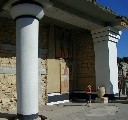 Our first stop after getting the car at half-past seven was at Knossós, the chief palace of Minoan Crete, and (with its sprawling size and innumerable rooms and passageways) the presumed inspiration for the labyrinth of mythology. (It is a very popular site, but we managed to beat the crowds.) Here, until about thirty-four centuries ago, the priest- or god-kings titled Minos ruled their empire, and presided over a civilization that at least materially was remarkably sophisticated, moreso for instance than the derivative Mycenaean culture that overlapped and followed it on the mainland. In view of the myth, we joked about its being a homecoming for our youngest child, Ariadne. It was in fact a return visit for Stas and me, who had come here on our bicycle tour in 1987.
Our first stop after getting the car at half-past seven was at Knossós, the chief palace of Minoan Crete, and (with its sprawling size and innumerable rooms and passageways) the presumed inspiration for the labyrinth of mythology. (It is a very popular site, but we managed to beat the crowds.) Here, until about thirty-four centuries ago, the priest- or god-kings titled Minos ruled their empire, and presided over a civilization that at least materially was remarkably sophisticated, moreso for instance than the derivative Mycenaean culture that overlapped and followed it on the mainland. In view of the myth, we joked about its being a homecoming for our youngest child, Ariadne. It was in fact a return visit for Stas and me, who had come here on our bicycle tour in 1987.
(Continuing from Mýrtos, Crete, Greece, Monday morning, 4 June 2001:)
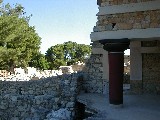
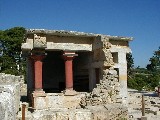 The palace at Knossós was not only excavated and described but also partially re-erected by Arthur Evans. Such reconstruction is not generally approved archaeological procedure, being prejudicial and destructive if it embodies a misinterpretation of the finds; in any case, it imposes the rebuilder's choice among the various chronological layers of the site. But it certainly does make the site more attractive and interesting for the non-specialist visitor, whose imagination is much assisted by it.
The palace at Knossós was not only excavated and described but also partially re-erected by Arthur Evans. Such reconstruction is not generally approved archaeological procedure, being prejudicial and destructive if it embodies a misinterpretation of the finds; in any case, it imposes the rebuilder's choice among the various chronological layers of the site. But it certainly does make the site more attractive and interesting for the non-specialist visitor, whose imagination is much assisted by it.
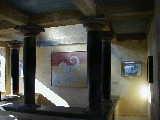
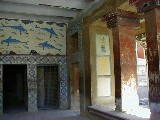 The frescoes in particular are all replicas. The originals are in the archaeological museum in Iráklio, and even there the fragments actually found are eked out with conjectural reconstruction. There one can clearly see where the faded and stained fragments end and the brighter reconstruction work begins, and that effect is reproduced in some of the replicas on site.
The frescoes in particular are all replicas. The originals are in the archaeological museum in Iráklio, and even there the fragments actually found are eked out with conjectural reconstruction. There one can clearly see where the faded and stained fragments end and the brighter reconstruction work begins, and that effect is reproduced in some of the replicas on site.
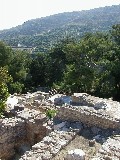
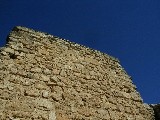 The prospect from the site across the valley very likely needs no reconstruction in order to resemble what it was in Minoan times. Likewise the look of Cretan sunshine on stone, and the blue Cretan sky.
The prospect from the site across the valley very likely needs no reconstruction in order to resemble what it was in Minoan times. Likewise the look of Cretan sunshine on stone, and the blue Cretan sky.
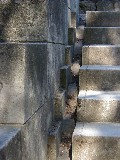
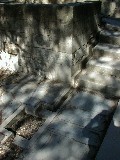 One of the less flashy but more impressive features of the palace is this staircase with its built-in spillway for water. The water would have been slowed in its descent by the series of steps all precisely curved for the purpose. This is found at the bottom of the sloped site; it would appear that water was channeled into the uphill side of the palace and came out at the downhill side. Among other things, this arrangement allowed for the famous flushing toilet in the queen's bathroom (though this was no longer to be seen). Presumably, though, this spillway and the channels and pools at its foot (right) were for cleaner effluent, and quite possibly for decorative effect.
One of the less flashy but more impressive features of the palace is this staircase with its built-in spillway for water. The water would have been slowed in its descent by the series of steps all precisely curved for the purpose. This is found at the bottom of the sloped site; it would appear that water was channeled into the uphill side of the palace and came out at the downhill side. Among other things, this arrangement allowed for the famous flushing toilet in the queen's bathroom (though this was no longer to be seen). Presumably, though, this spillway and the channels and pools at its foot (right) were for cleaner effluent, and quite possibly for decorative effect.

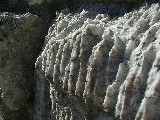 The architect of the palace--Daedalus in myth--would seem to have had a fondness for gypsum. Even a throne found here was made of it. In the fifteenth-century-B.C. fire that destroyed the palace, much of this gypsum was curiously affected, so that its crystalline structure (left) was disrupted and the stone rendered vulnerable to water erosion (right).
The architect of the palace--Daedalus in myth--would seem to have had a fondness for gypsum. Even a throne found here was made of it. In the fifteenth-century-B.C. fire that destroyed the palace, much of this gypsum was curiously affected, so that its crystalline structure (left) was disrupted and the stone rendered vulnerable to water erosion (right).
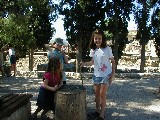 During a break for sitting in the shade, the children played butcher shop. They have been impressed by the kreopolía of Greece, where the kimá (ground beef) is always ground to order by a butcher who seldom affects gloves nor ever seems to wash his hands between orders or between handling meat and money--and where lamb carcasses with heads, or even wild boars with heads and bristles, are routinely hung up on the hooks.
During a break for sitting in the shade, the children played butcher shop. They have been impressed by the kreopolía of Greece, where the kimá (ground beef) is always ground to order by a butcher who seldom affects gloves nor ever seems to wash his hands between orders or between handling meat and money--and where lamb carcasses with heads, or even wild boars with heads and bristles, are routinely hung up on the hooks.
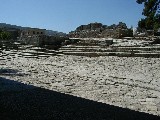 Our way out took us through the "theatral area," so called because it looks vaguely like a ritual or other performance space, but I do not think anyone knows what it was for.
Our way out took us through the "theatral area," so called because it looks vaguely like a ritual or other performance space, but I do not think anyone knows what it was for.


 Then we doubled back to Iráklio. I parked the car--illegally, it turned out--and while the rest had refreshments I walked to the office of a travel agent, where I picked up the papers for our next ferry and rental car, which I had booked via the web. Then we all toured the archaeological museum, which houses finds from Knossós and other Minoan sites. The standard picture-postcard pieces here are a golden brooch in the form of two bees, a faience figurine of a bare-breasted priestess or goddess holding snakes, and a rhyton (ritual drinking-cup) in the form of a bull's head. My own photography, however, was only successful with such pottery as was not behind glass. Minoan pottery has a delightful exuberance about it, quite different from the later classical styles. Here are two octopus vases (a favorite motif as heretofore noted), and a floral one.
Then we doubled back to Iráklio. I parked the car--illegally, it turned out--and while the rest had refreshments I walked to the office of a travel agent, where I picked up the papers for our next ferry and rental car, which I had booked via the web. Then we all toured the archaeological museum, which houses finds from Knossós and other Minoan sites. The standard picture-postcard pieces here are a golden brooch in the form of two bees, a faience figurine of a bare-breasted priestess or goddess holding snakes, and a rhyton (ritual drinking-cup) in the form of a bull's head. My own photography, however, was only successful with such pottery as was not behind glass. Minoan pottery has a delightful exuberance about it, quite different from the later classical styles. Here are two octopus vases (a favorite motif as heretofore noted), and a floral one.

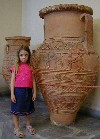 Sculptural and painted decoration are often combined, but the former predominates on the large vessels called pithoi: at left, ropes and "medallions," and at right, sphinxes and snakes.
Sculptural and painted decoration are often combined, but the former predominates on the large vessels called pithoi: at left, ropes and "medallions," and at right, sphinxes and snakes.
After all this and a number of wrong turns coming back out of Iráklio--the Cretans seem to retain even in peacetime their war on road signage--we still managed to reach the pretty beach resort of Áyia Galíni on the opposite (south) side of the island, in time for a leisurely visit to the beach before dinner. Crossing the island north to south, across its mountainous spine, is a lot easier and faster by car than by loaded bicycle, the way we did it on a certain long day fourteen years ago, against a headwind.

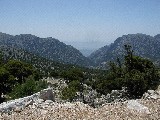 The next day we ventured back to the mountainous interior, searching for a cave on Mount Ida that had associations with the myth of the birth and secret rearing of Zeus. (Another cave, on Mount Dicte, competes for many of the same associations.) We never did find our cave, but wound up driving for hours in first gear on unpaved roads very high. Despite my best efforts, rocks continually scraped the bottom of our car, and the prospect of its ceasing to function was even more terrifying than the unfenced precipices. The views were spectacular, however.
The next day we ventured back to the mountainous interior, searching for a cave on Mount Ida that had associations with the myth of the birth and secret rearing of Zeus. (Another cave, on Mount Dicte, competes for many of the same associations.) We never did find our cave, but wound up driving for hours in first gear on unpaved roads very high. Despite my best efforts, rocks continually scraped the bottom of our car, and the prospect of its ceasing to function was even more terrifying than the unfenced precipices. The views were spectacular, however.
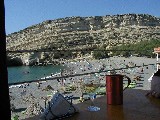

 Glad to be still alive, we made our way back to the coast, this time at Mátala. We lunched at a taverna overlooking the beach, where we soon joined the swimmers and sunbathers. In two of these photos you can see the massif riddled with artificial caves at the north end of the westward-facing beach. Admission is now charged to these, and the site is identified at the gate as a Roman cemetary. A few decades back, however, they helped make the place a celebrated Mecca for hippies and beach bums.
Glad to be still alive, we made our way back to the coast, this time at Mátala. We lunched at a taverna overlooking the beach, where we soon joined the swimmers and sunbathers. In two of these photos you can see the massif riddled with artificial caves at the north end of the westward-facing beach. Admission is now charged to these, and the site is identified at the gate as a Roman cemetary. A few decades back, however, they helped make the place a celebrated Mecca for hippies and beach bums.
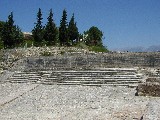
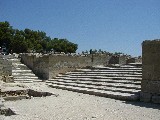
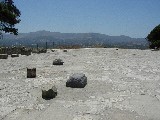 The next day, Larissa's birthday, we went first to the Minoan palace site of Festós. This is not so reconstructed as that at Knossós, and one can more clearly discriminate the different periods, "neopalatial" (fifteenth-century B.C.) and the yet earlier "protopalatial." Here you see another stepped "theatral area," some further stairs, and the broad central court, of which the first and last would appear to date from the earlier period; the grand staircase was the entrance to the later version of the palace.
The next day, Larissa's birthday, we went first to the Minoan palace site of Festós. This is not so reconstructed as that at Knossós, and one can more clearly discriminate the different periods, "neopalatial" (fifteenth-century B.C.) and the yet earlier "protopalatial." Here you see another stepped "theatral area," some further stairs, and the broad central court, of which the first and last would appear to date from the earlier period; the grand staircase was the entrance to the later version of the palace.
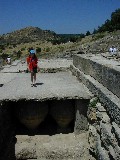
 Here are some more protopalatial bits, including a sunken storeroom with relief-decorated pithoi.
Here are some more protopalatial bits, including a sunken storeroom with relief-decorated pithoi.
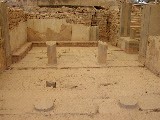
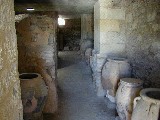 And here are some more neo-palatial bits: a portion of the royal apartment that used to feature both a polythyron ("many-doors," i.e. a space defined by panels that could be opened at will) and a light well; and a storeroom full of pithoi.
And here are some more neo-palatial bits: a portion of the royal apartment that used to feature both a polythyron ("many-doors," i.e. a space defined by panels that could be opened at will) and a light well; and a storeroom full of pithoi.
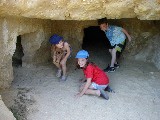
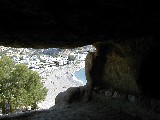 Afterwards we returned to Mátala for another beach session, followed by a visit to the caves. At the beach, we met and chatted with an American couple who had retired to this part of Crete. These were not the only other Americans we noted here, but the tourist trade seems very German-dominated.
Afterwards we returned to Mátala for another beach session, followed by a visit to the caves. At the beach, we met and chatted with an American couple who had retired to this part of Crete. These were not the only other Americans we noted here, but the tourist trade seems very German-dominated.
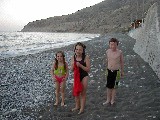 After all this, and another long drive with some wrong turns, Larissa was barely and briefly able to fulfill her birthday wish of visiting two beaches in one day. We did not have to worry about more sun on already burned skin, since Helios had already gone behind the mountain, and as you can see the heat of day is past. This beach at Mýrtos was the first place I ever swam in the Mediterranean, fourteen years ago.
After all this, and another long drive with some wrong turns, Larissa was barely and briefly able to fulfill her birthday wish of visiting two beaches in one day. We did not have to worry about more sun on already burned skin, since Helios had already gone behind the mountain, and as you can see the heat of day is past. This beach at Mýrtos was the first place I ever swam in the Mediterranean, fourteen years ago.
(Continuing from P/F Vitséntzos Kornáros, Tuesday morning, 5 June 2001:)
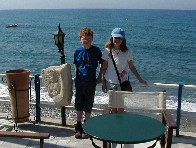 Yesterday morning we walked along the sea front at Mýrtos and found breakfast a ways east of the place in the photo here. Then we set out for the Dictean cave, reputedly the more picturesque of the two rival claimants for the status of legendary birthplace of Zeus. Yet again we were frustrated in trying to find the place, and found ourselves on some terrifyingly steep and narrow roads in the attempt. We decided to turn back and go around the mountain the other way, with a stop at out next night's lodging at Áyios Nikólaos, so that the trip to the cave could be optional. Once the luggage had all been lugged up the three flights of stairs to our unexpectedly expensive rooms, Larissa and I set out for the cave.
Yesterday morning we walked along the sea front at Mýrtos and found breakfast a ways east of the place in the photo here. Then we set out for the Dictean cave, reputedly the more picturesque of the two rival claimants for the status of legendary birthplace of Zeus. Yet again we were frustrated in trying to find the place, and found ourselves on some terrifyingly steep and narrow roads in the attempt. We decided to turn back and go around the mountain the other way, with a stop at out next night's lodging at Áyios Nikólaos, so that the trip to the cave could be optional. Once the luggage had all been lugged up the three flights of stairs to our unexpectedly expensive rooms, Larissa and I set out for the cave.


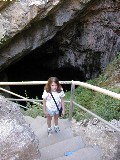 This time, with Larissa navigating, we did succeed in reaching it. Once we reached the parking lot we had still to climb up a rock-paved trail for about a kilometer. Donkeys were available to ride up, for a price, but Larissa disdained them, so we proceeded on foot, avoiding their road apples. At left you can see a prospect from the trail, looking out over the flat and instensively cultivated Lasíthi Plateau, something over 700 meters in elevation. It was formerly noted for its sea of windmills, but few are any longer in operation. At right, Larissa starts down the stairs into the cave; as you can see in the other picture, the stairs continue down and down into the steeply slanted cavern.
This time, with Larissa navigating, we did succeed in reaching it. Once we reached the parking lot we had still to climb up a rock-paved trail for about a kilometer. Donkeys were available to ride up, for a price, but Larissa disdained them, so we proceeded on foot, avoiding their road apples. At left you can see a prospect from the trail, looking out over the flat and instensively cultivated Lasíthi Plateau, something over 700 meters in elevation. It was formerly noted for its sea of windmills, but few are any longer in operation. At right, Larissa starts down the stairs into the cave; as you can see in the other picture, the stairs continue down and down into the steeply slanted cavern.


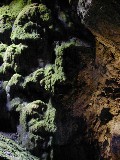 The cave is rich in stalactites and stalagmites, but I was even more struck by the literal grotesques shown right, which get some natural light from the entrance and accordingly are covered in green moss. The one at the bottom of this natural ten-meter totem pole suggests to me the head of a gryphon or vulture, while that at the top looks like Mr. Punch.
The cave is rich in stalactites and stalagmites, but I was even more struck by the literal grotesques shown right, which get some natural light from the entrance and accordingly are covered in green moss. The one at the bottom of this natural ten-meter totem pole suggests to me the head of a gryphon or vulture, while that at the top looks like Mr. Punch.

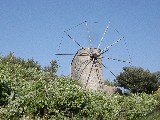 On our way back to Áyios Nikólaos we stopped to buy a bag of oranges from the picturesque old Cretan shown left. The oranges were not very good, but the photo op was worth the price. We also found a nice old windmill, not on the plateau but in a notch of the hills around it.
On our way back to Áyios Nikólaos we stopped to buy a bag of oranges from the picturesque old Cretan shown left. The oranges were not very good, but the photo op was worth the price. We also found a nice old windmill, not on the plateau but in a notch of the hills around it.
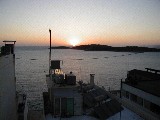
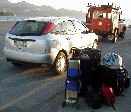 This morning in Áyios Nikólaos we all got up just as rosy-fingered dawn appeared in the east (very pretty from the top of the pension), and packed all our heap of luggage and ourselves into the tiny car one last time to for the short hop to the ferry port. It is amazing how much luggage and people we managed to fit into it, and perhaps the less wonder why the rocky roads of Ida were so rough on its underside. The night before, when I had gone to return the car (naturally after hauling every bit of the luggage up those three flights), I had been advised that after all somebody could be on hand to take the car back before regular office hours in the morning, so that we need not bother with a cab. Both that somebody and we ourselves might just as well have slept in, however, for the ferry was late by an hour and three quarters. (Still, that is better than the eight or nine hours we had to wait, at night and in bad weather, for the same trip fourteen years ago!)
This morning in Áyios Nikólaos we all got up just as rosy-fingered dawn appeared in the east (very pretty from the top of the pension), and packed all our heap of luggage and ourselves into the tiny car one last time to for the short hop to the ferry port. It is amazing how much luggage and people we managed to fit into it, and perhaps the less wonder why the rocky roads of Ida were so rough on its underside. The night before, when I had gone to return the car (naturally after hauling every bit of the luggage up those three flights), I had been advised that after all somebody could be on hand to take the car back before regular office hours in the morning, so that we need not bother with a cab. Both that somebody and we ourselves might just as well have slept in, however, for the ferry was late by an hour and three quarters. (Still, that is better than the eight or nine hours we had to wait, at night and in bad weather, for the same trip fourteen years ago!)

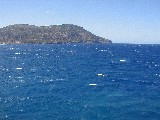
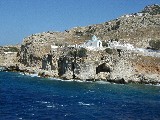 To the left is one of our last sights of Crete, looking south from the ship at the coast by Papadiókambos, a little west of Sitía. To the right are some photos of the port of Kárpathos, one of several ports of call along the way. The photos cannot begin to capture the intense cobalt blue of the sea.
To the left is one of our last sights of Crete, looking south from the ship at the coast by Papadiókambos, a little west of Sitía. To the right are some photos of the port of Kárpathos, one of several ports of call along the way. The photos cannot begin to capture the intense cobalt blue of the sea.
Wednesday afternoon, 6 June 2001, outside the city (and on the island) of Rhodes:
We landed at ten p.m. last night, but there was considerable further delay in mooring the ship in a high crosswind. We found our rental car waiting for us, but again we were disappointed of the hoped-for and bespoke Seat Cordoba; the Hyundai Accent we got was even less capacious than the Ford Focus. (We had to go in shifts to the rental office, as we could barely fit ourselves and our gear in even with the trunk bungeed, and the company representative had to go there too.) We were also disappointed of our accommodation, as the place I had booked was in the old town, and we learned that cars and even taxis are prohibited there, so that taking our luggage there would be nearly impossible. We seriously thought of ditching the car altogether, but finally decided to take it, even paying for the night-delivery charge incurred through the ferry's delay. Then we set off down the coastal highway to the southwest away from the city until we found a hotel with parking that did not look too pricy (one letter was missing from the sign of its name, the "Lito"), about four kilometers out of town. It still turned out to be a little dear for us, but at least it is cheaper than the pension in Áyios Nikólaos, and has such amenities as a pool (where I am lifeguarding the children as I write), a bar, and included breakfast. I breakfasted alone this morning, however, while the rest slept till after service had ended.

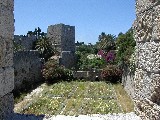
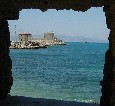 Afterwards we availed ourselves of a laundry service that offered not only service wash but hotel pickup and delivery, and set out for the car rental office. We found it with considerable difficulty; streets here are rarely labeled at all, so even with a map it is singularly hard to navigate. But find it we did, eventually, and fortunately we were able to park right in front, and exchange the car for a much more capacious one, which was also parked in front, where we learned we could leave it all day without charge. So we set out on foot to tour the remarkably well-preserved and almost exclusively pedestrian old town--the walled medieval city of the Knights Hospitallers of the order of St. John of Jerusalem.
Afterwards we availed ourselves of a laundry service that offered not only service wash but hotel pickup and delivery, and set out for the car rental office. We found it with considerable difficulty; streets here are rarely labeled at all, so even with a map it is singularly hard to navigate. But find it we did, eventually, and fortunately we were able to park right in front, and exchange the car for a much more capacious one, which was also parked in front, where we learned we could leave it all day without charge. So we set out on foot to tour the remarkably well-preserved and almost exclusively pedestrian old town--the walled medieval city of the Knights Hospitallers of the order of St. John of Jerusalem.

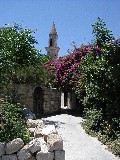 Along the way I picked up our ferry tickets for Kos. Then we went in through the Marine Gate (left). Stas, being the only one of us not in shorts, ventured into one of the city's mosques (the minaret of another can be seen at right)--anathema to the knights but a living vestige of the ensuing Ottoman regime. As we walked through the delightful old city I recognized several streetscapes from our previous visit. We lunched at the place we should have stayed, and I duly apologized for not showing to claim the rooms. After lunch we came back to the hotel so the children could have their eagerly-awaited swim in the pool.
Along the way I picked up our ferry tickets for Kos. Then we went in through the Marine Gate (left). Stas, being the only one of us not in shorts, ventured into one of the city's mosques (the minaret of another can be seen at right)--anathema to the knights but a living vestige of the ensuing Ottoman regime. As we walked through the delightful old city I recognized several streetscapes from our previous visit. We lunched at the place we should have stayed, and I duly apologized for not showing to claim the rooms. After lunch we came back to the hotel so the children could have their eagerly-awaited swim in the pool.
previous entry
next entry
main/ToC page


 In our last month at Litóhoro, we had a lot of work and things to wrap up but still took a couple more hikes in the Enipea gorge. On the fifth of May, with Stas in England, I took the kids up. We took a novel route upward through town and happened across the gaily painted old house that is the "Pansion" Kallistô (left). Then we took the aqueduct trail to the dam, and found a way for the first time to go dry-shod (well, almost) up well past the next bend upstream, discovering new and lovely scenes.
In our last month at Litóhoro, we had a lot of work and things to wrap up but still took a couple more hikes in the Enipea gorge. On the fifth of May, with Stas in England, I took the kids up. We took a novel route upward through town and happened across the gaily painted old house that is the "Pansion" Kallistô (left). Then we took the aqueduct trail to the dam, and found a way for the first time to go dry-shod (well, almost) up well past the next bend upstream, discovering new and lovely scenes.











 The palace at Knossós was not only excavated and described but also partially re-erected by Arthur Evans. Such reconstruction is not generally approved archaeological procedure, being prejudicial and destructive if it embodies a misinterpretation of the finds; in any case, it imposes the rebuilder's choice among the various chronological layers of the site. But it certainly does make the site more attractive and interesting for the non-specialist visitor, whose imagination is much assisted by it.
The palace at Knossós was not only excavated and described but also partially re-erected by Arthur Evans. Such reconstruction is not generally approved archaeological procedure, being prejudicial and destructive if it embodies a misinterpretation of the finds; in any case, it imposes the rebuilder's choice among the various chronological layers of the site. But it certainly does make the site more attractive and interesting for the non-specialist visitor, whose imagination is much assisted by it.






























 Yesterday morning we walked along the sea front at Mýrtos and found breakfast a ways east of the place in the photo here. Then we set out for the Dictean cave, reputedly the more picturesque of the two rival claimants for the status of legendary birthplace of Zeus. Yet again we were frustrated in trying to find the place, and found ourselves on some terrifyingly steep and narrow roads in the attempt. We decided to turn back and go around the mountain the other way, with a stop at out next night's lodging at Áyios Nikólaos, so that the trip to the cave could be optional. Once the luggage had all been lugged up the three flights of stairs to our unexpectedly expensive rooms, Larissa and I set out for the cave.
Yesterday morning we walked along the sea front at Mýrtos and found breakfast a ways east of the place in the photo here. Then we set out for the Dictean cave, reputedly the more picturesque of the two rival claimants for the status of legendary birthplace of Zeus. Yet again we were frustrated in trying to find the place, and found ourselves on some terrifyingly steep and narrow roads in the attempt. We decided to turn back and go around the mountain the other way, with a stop at out next night's lodging at Áyios Nikólaos, so that the trip to the cave could be optional. Once the luggage had all been lugged up the three flights of stairs to our unexpectedly expensive rooms, Larissa and I set out for the cave.

















